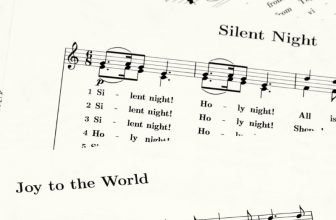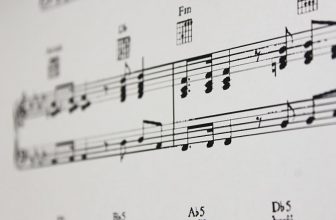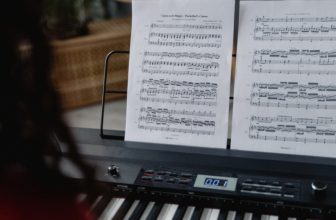Hook vs Chorus – What’s the Difference?

A chorus is a section of a song usually preceded and succeeded by a verse and repeated multiple times throughout the composition. A hook is a short musical phrase that’s heavily featured in the composition but that doesn’t constitute a section of a song per se.
Song sections are very important for arranging a song. Most pop-rock tunes feature a verse (a repeated section containing new lyrics), a bridge (a lead-up to the chorus), and a chorus (the catchiest moment in the song, with repeated lyrics). So, when does the hook come in?
A hook is a part of any composition, but it’s not a section of a song like a chorus. Think of it as the short musical motif within the composition that sticks to the head. While a chorus is generally a long musical phrase featuring lyrics, hooks are mainly instrumental and very short, like a bass groove, a catchy guitar riff, or even a horn section melody.
To have a better understanding of what separates a chorus from a hook, let’s look at some classic examples.
What’s the difference between a hook and a chorus (with examples)?
With “Uptown Funk,” Mark Ronson and Bruno Mars delivered one of the best pop songs of the 2010s. The tune is as memorable as it gets, and it’s also great for understanding the differences between a hook and a chorus.
“Uptown Funk” – The Hook
Like most songs, “Uptown Funk” starts with the hook. The song’s hook is the “Doh doh doh, doh doh doh, doh doh” line sung by a male choir before the start of the first verse. Once the verse hits, the hook stops and gives way to Bruno Mars’s singing.
However, the hook doesn’t function merely as an intro to the song. It comes back again and again, even during the chorus section. In a nutshell, it’s the short, basic music idea around which the entire composition develops.
As stated by its name, the “hook” is supposed to be what gets you “hooked” to the song and makes you want to continue to listen to it.
“Uptown Funk” – The Chorus
When the first verse ends, the bridge of “Uptown Funk” starts. It’s a classic bridge because it creates tension before the release of the chorus. The chorus itself begins a few seconds later, around 1:08, and features the return of the hook that had been previously introduced.
Notice that, as Bruno Mars sings “Don’t believe me just watch,” the “Doh doh doh, doh doh doh, doh doh” hook presented at the beginning of the song makes an exciting comeback. Meanwhile, the arrangement introduces a second hook: a horn-section melody that hadn’t been featured in the song before.
It goes to show that most choruses do contain the song’s main hook and that many can feature additional hooks. Needless to say, songs may contain multiple hooks, not just one.
Other examples
Britney Spears’s classic “Oops!…I Did It Again” contains one of the most memorable chorus sections ever made. The song is also exemplary in showing the emotional roles portrayed by a hook and a chorus in the context of a great pop tune.
“Oops!…I Did It Again” – The Hook
When the song starts, its listeners are immediately introduced to the hook: a powerful, short piano riff that’s featured throughout the entire composition, including the verses. Why is it such a great hook? Because it allows everybody to know that they’re listening to “Oops!…I Did It Again” from the very start.
That’s why everybody in the club goes mad as soon as the song starts: since its hook is effective, we’re able to recognize we’re listening to “Oops!…I Did It Again” in less than a second.
“Oops!…I Did It Again” – The Chorus
When the chorus of the song starts, the hook gives way to Britney Spears’s singing, which should be the main focus of attention. While the hook is vital in making “Oops!…I Did It Again” recognizable from the very start, the chorus is the section when people join in to sing along.
That’s why choruses, unlike verses, keep the same lyrics throughout a composition. Because choruses work as a moment of communion between the artist and the listener. When a chorus is good enough, everybody will want to join in.
“Shape of My Heart” – The Hook
In Sting’s magnificent “Shape of My Heart,” the hook isn’t as instantly recognizable because it makes for a more complex musical phrase. It’s not just a “doh doh” or a two-note piano riff; it’s a guitar melody that changes chords and even contains a b-side.
However, that doesn’t mean it’s not a textbook hook. Notice how the entirety of “Shape of My Heart” seems to be contained in that first riff, featured only once before the start of the verses. It’s as if Sting is explaining to the listeners what’s going to happen, inviting them on a journey.
“Shape of My Heart” – The Chorus
When the first verse ends and the listener has almost forgotten about the hook presented in the intro, the chorus to “Shape of My Heart” starts. Smartly, Sting sings the entire chorus on top of that initial guitar riff (the hook). The chorus sounds instantly more exciting because it’s recognizable, even if you’re listening to the song for the first time, it sounds relevant and familiar.
“Shape of My Heart” is important in distinguishing hooks and choruses because it treats us with a hook that is, to put it simply, the instrumental to the chorus. That doesn’t mean the hook and the chorus are the same. The hook is the guitar phrase – the riff played by Sting. The chorus is the whole section – including Sting’s voice, the guitar riff, and all other instruments.
Summary
Many people confuse the hook and the chorus because they have a similar role: to grab the listener and provide him with something catchy, something he or she can hum and sing along to. Hooks and choruses are musical best friends, but they’re radically different.
Songs can have multiple hooks, which are generally very short musical phrases. With very rare exceptions, songs have just one chorus, which is about 8 to 16 bars long, and may or may not contain one of the hooks previously featured in the composition.
Can you make a great chorus without a hook? I’m tempted to believe you can’t. Can you make a great hook without a chorus? Yes, but you’ll still need a chorus to make it work in the context of a song. In other words, hooks and choruses are two separate concepts that co-exist harmoniously in a song. Well, at least in the very best songs!





